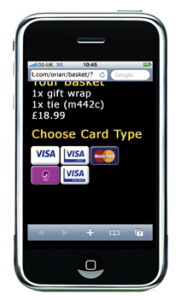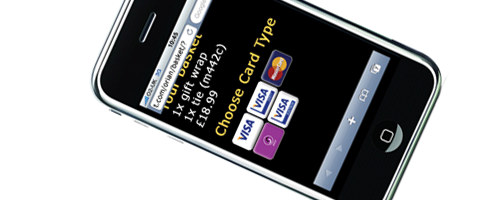Last month, Tara Kuczykowski walked into a Target store in Columbus, Ohio, pulled out her mobile phone and handed it to the cashier.
The cashier scanned the digital coupon on the phone’s tiny screen, and Kuczykowski got $1 off sandwich-size Ziploc bags. Target got something, too: another entry in its database about her.
At the recent, July ’11, IAB Engage for Mobile event in London, Ashley Highfield, UK managing director, Microsoft (Consumer & Online), explained how 28% of all internet time is spent on smartphones, and that of the 45 million mobile users in the UK, 23 million are ‘using’ m-commerce. Adding that the next six to 12 months would mark a period of dramatic growth.
- Google saw a threefold increase in retail-related search terms in the past year.
- eBay is reportedly selling an item per second via mobile.
- Around 10% of all orders on Ocado come from its app.
- House of Fraser has seen 600% increase in mobile sales since June 2010.
- 19% of bets at PaddyPower are now made via its mobile site.
- One third of UK shoppers engaged in mCommerce during Christmas 2010.
Google, at IAB Engage for Mobile 2011, highlighted that 50% of all mobile site visits start with search, and over 80% of the sites that they serve following that search query are NOT mobile optimised.
According to research published on May 31st, the mobile commerce industry could be worth up to £19bn by 2021. The research, conducted by Verdict on behalf of eBay, shows that mobile shopping is ‘on the verge’ of increasing four-fold in the next four years and could deliver £4.5bn by 2016 with a further £13bn by 2021.
Certainly the market has reached a tipping point –the question is no longer can brands afford to create and experiment with M-Commerce platforms but what revenues are they missing by not being on the platforms in the first place?
We can broadly split mobile commerce into customer shopping behaviours and client-side technical payment facilitation.
Customer-focussed m-commerce activity includes receiving adverts about products/services, searching for product information, comparing prices and after-sales service, as well as actually buying things.
What we are now beginning to see is that mobile access to online sites and services allows customers to return to high streets and actually look at and touch products, but with all the back up of price comparisons and customer recommendations available a text message or few short mobile internet pages away to help inform final buying decisions.
As can be seen from theUSexample cited earlier, retailers and brands can use SMS-delivered mobile coupons and vouchers to trigger or nudge those decisions in their favour in as timely and location-specific a manner as they want.
Facilitating payment mechanisms through mobiles is more complicated – with factors such as security, integration with legacy systems and financial processes, let alone high revenue share fees from networks and other issues to consider.
With increasing case study evidence and results showing the sales successes and uplifts that retailers and brands can achieve in engaging customers; improved devices (bigger screens; faster, more robust network connectivity; clearer data plans and richer mobile shopping environments – sites and apps) are overcoming customer reticence (37% of Europeans “tried” m-commerce in 2009, according to an ATG survey); and now with bank-approved security and online payment mechanisms that integrate seamlessly with existing financial back-ends from providers such as Incentivated, retailers are increasingly able to provide the same access to purchasing products through mobile phones as they do through the fixed internet.
Stephen Robertson, director general of the British Retail Consortium, says:
“Consumers are always looking for more convenient ways to shop. Retailers are making m-commerce easier all the time by offering mobile optimised websites, apps and transactional mobile platforms.”
Another factor that is increasing in its adoption – and thus helping to drive consumer willingness to transact via their phones – is the inclusion of mobile solutions within traditional advertising and communications channels.
Advertisers are gradually increasing their use of QR codes, SMS short codes, even NFC (Near Field Communication) chips to bring customers to websites, coupons or even deep-linked into app stores to get the specific branded application for their phone.
Mobile commerce really began with premium-charged SMS, as people bought, in their droves, personalised ringtones, culminating in the cultural aberration that was “Crazy Frog”.
These have now evolved into much more socially acceptable ways of delivering useful public sector information in a way that doesn’t impact on council tax bills. e.g:
- Cabwise provides access to licensed taxi firms
- Services that can point out the nearest public toilet
- Services that allow you to find out your recycling day and materials taken
- Services that allow you to report graffiti, or fly-tipped rubbish/cars etc
Charities have now made it much easier to donate simple amounts, whether for a specific event or on an ad hoc basis, simply by sending an SMS with a call to action added to pre-existing marketing materials.
 Now, as screen sizes have increased and data entry on-screen becomes less fiddly, we can see that customers are happy to enter their credit card details into a secure payment page on a mobile optimised website or into an app.
Now, as screen sizes have increased and data entry on-screen becomes less fiddly, we can see that customers are happy to enter their credit card details into a secure payment page on a mobile optimised website or into an app.
The web or app conversation is a complicated one – there are very good reasons for the use of either, or even both, depending upon a variety of factors.
The really key client decision for this area of “true” form of commercial transaction via a mobile device becomes one of integration.
Do you integrate your website/ app with your existing website management tool – your CMS?
And do (can) you integrate your payment platform with your existing eCommerce platform or do you run standalone site and payments – e.g. for speed, cost, expediency reasons.
The issue with the latter is of course one of measurement, reporting and integrating results with traditional offline and online factors as you try and establish a ‘single customer view’ of any given individual’s interactions with your brand.
Whatever stage you are at in considering mobile and commerce, it’s not too late to be early. Only 26 of theUK’s top 100 retailers currently have an optimised for mobile website – let alone a fully transactional site.
For the best advice in negotiating the myriad of technical questions that mobile throws up, always speak to a mobile specialist. Mobileisn’t difficult, but it is complex – and, because it’s still fairly ‘new’, mobile commerce particularly so at the moment.
For our white paper on mCommerce or on other mobile topics, please visit: http://www.incentivated.com/web/white-papers.aspx






